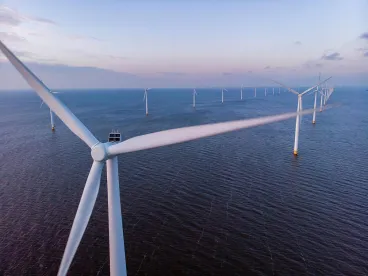With the rise and rapid progression in the development of the offshore wind industry, including the advent of US Jones Act-compliant offshore wind vessels,[1] operators and other entities within the supply chain should be aware not only of Jones Act cabotage laws[2] but also of the varying legal regimes applicable to offshore facilities and employees working in the construction, repair, and operation of wind farms. Offshore wind operations can involve Jones Act seamen, maritime employees, and other non-maritime employees. Whether a worker falls under the Jones Act or the Longshore and Harbor Workers’ Compensation Act (LHWCA) will dictate the rights and remedies of these workers in the case of injury or accident. Furthermore, the classification of various offshore structures, i.e., vessel vs. non-vessel, determines what law applies to not only the workers aboard them but also the contracts governing their operations. Understanding the classifications of these employees as well as the structures on which they work is crucial for risk management assessment and insurance coverage needs.
Vessel Status
In the offshore wind industry, everything that floats is not a vessel and every maritime worker is not a Jones Act seaman. In determining remedies arising from offshore disputes, situs and status matter. The US Supreme Court recognized that “the inquiry into seaman status is of necessity fact specific; it will depend on the nature of the vessel and the employees’ precise relation to it.” Thus, vessel status is an important predicate in determining seaman status and also in accessing what law may apply to an offshore service contract.
In Lozman v. City of Riviera Beach, the Court decided that a houseboat not involved in maritime commerce was not a vessel: “Not every floating structure is a vessel”[3] Traditionally, moored but floating work platforms have been held not to be vessels for Jones Act or other purposes.[4]
In offshore operations involving deep water projects, the offshore industry has designed and constructed floating production platforms that are moored to the ocean floor for their useful life. These floating production units, tension-leg platforms, and spar units while floating are not considered vessels in navigation for Jones Act status purposes.[5]
Other offshore floating construction and drilling units, which are jacked up while on location but regularly move from location to location — such as lift boats, mobile offshore drilling units, feeder support vessels, and wind-turbine installation vessels — are likely vessels engaged in maritime commerce.[6] Workers injured on offshore facilities may have remedies under the Jones Act, the LHWCA, or state workers’ compensation laws depending on situs and status.
Contract Status
Besides playing a role in the classification of workers, whether or not an offshore structure or watercraft qualifies as a “vessel in navigation” also determines what laws may apply to the contracts governing its operations. Disputes arising in the Gulf of Mexico can be subject to several bodies of law: maritime law, federal law applied under the Outer Continental Shelf Lands Act (OCSLA), and state law. State law may apply either as surrogate federal law under the OCSLA or because the platform facility is operating within state territorial waters.
In a nutshell, when a contract contemplates the substantial use of “vessel in navigation,” it will be considered a maritime contract and, therefore, subject to substantive maritime law, which is uniform throughout the country.[7] On the other hand, if the contract does not contemplate a vessel playing a substantial role in the completion of the work, the contract will be subject to state law (or whatever law the parties contracted would apply). This distinction makes all the difference when it comes to contractual clauses for indemnity, which in turn affects insurance obligations. Generally speaking, parties to a maritime contract negotiate “knock-for-knock” indemnity — essentially meaning if one of my workers suffers an injury, I will indemnify you regardless of your fault. This maritime contract would be subject to maritime law, and this knock-for-knock indemnity would be valid and enforceable. On the other hand, if the contract is not maritime in nature and is subject to Louisiana or Texas law, both Louisiana and Texas have enacted statutes that prohibit contract clauses that indemnify a party for their own negligence. As such, this knock-for-knock indemnity would potentially be void and unenforceable. Accordingly, the determination of whether a structure qualifies as a vessel and whether maritime law applies becomes crucial for not only the determination of the status of offshore workers but also for the determination of insurance and indemnity obligations and quantifying risks.
Worker Status
The Merchant Marine Act of 1920, commonly known as the Jones Act, grants seamen who are injured in the course and scope of their employment the right to sue their employer for personal injury damages. Whether a worker qualifies as a Jones Act seaman is subject to a two-part test: (1) the worker must contribute to the function of a vessel; and (2) the worker must have a connection to the vessel (or a fleet of vessels) that is substantial in both nature and duration.[8] In recent years, the US Court of Appeals for the Fifth Circuit[9] has further narrowed the scope of the “substantial in nature” prong by directing lower district courts to also consider the following three inquiries:
- Does the worker owe his allegiance to the vessel rather than simply to a shoreside employer?
- Is the work sea-based or involve seagoing activity?
- (a) Is the worker’s assignment to a vessel limited to performance of a discrete task after which the worker’s connection to the vessel ends, or (b) does the worker’s assignment include sailing with the vessel from port to port or location to location?
With this test in mind, it is clear that the captain and crew of an offshore supply or construction vessel would qualify as Jones Act seamen. On the contrary, an engineer aboard a fixed offshore wind installation would not be considered a seaman, because he has no connection to a vessel in navigation. On the other hand, a contract worker assigned to operate equipment on a barge or work platform presents a less clear case. His or her status as a seaman will depend on the vessel status[10] of the watercraft and the worker’s connection to same. In these gray-area cases, seaman status will be a highly fact-sensitive inquiry depending on the totality of the circumstances and the worker’s ultimate connection to a vessel.
If a worker qualifies as a seaman, in the case of injury, the seaman can bring the typical tripartite causes of action against his or her employer: (1) maintenance and cure; (2) unseaworthiness; and (3) Jones Act negligence. A Jones Act employer owes an absolute duty to provide maintenance and cure to a seaman who is injured or becomes ill in the service of the vessel, and such claims arise regardless of fault. This claim also exists independently of the seaman’s claims of unseaworthiness or negligence.[11] In addition to claims against his or her employer, the seaman may also bring general maritime law claims against third-party non-employers.
If an employee does not qualify as a Jones Act seaman, the employee could potentially fall under the LHWCA in two situations. To qualify as a LHWCA employee, a worker must meet both the “status” and “situs” tests of the LHWCA. In short, the employee must: (1) engage in maritime employment; and (2) be injured upon the navigable waters of the United States. If the employee meets these two prongs, the LHWCA provides for payment of medical, surgical, and other treatment, as well as disability benefits, including temporary or permanent disability. The LHWCA, however, is the worker’s exclusive remedy against his or her employer.[12] The LHWCA typically includes longshoremen, harbor workers, stevedores, and other workers at ports and marine terminals, as well as shipbuilders and ship repairmen. Likewise, the OCSLA extends the benefits conferred by the LHWCA to employees working on the Outer Continental Shelf (OCS) in the exploration and development of natural resources.[13] With respect to the offshore wind industry, Congress amended the OCSLA in 2021 to include installations that produce “non-mineral energy resources,”[14] as under its jurisdiction. As such, because the OCSLA now includes offshore wind farms and other renewable energy installations under its ambit of jurisdiction, the LHWCA, and its compensation and benefits scheme, will extend to workers in the offshore renewable energy sphere as well. In addition to those statutorily mandated payments, an LHWCA employee injured on a vessel may also bring what is known as a 905(b) claim against a vessel owner for vessel negligence.[15] Again, whether a structure qualifies as a vessel in the first instance will determine whether an offshore worker covered under the LHWCA may bring such a claim.
Lastly, if an employee does not qualify as a seaman or other maritime worker, a non-maritime employee would be covered by the applicable state workers’ compensation laws if the LHWCA does not apply. These non-maritime workers could be management personnel or other employees who visit offshore wind installations or other offshore structures on an occasional basis. Although a non-maritime employee would be unable to pursue a cause of action against his or her employer, if the employee becomes injured while aboard a third party’s vessel, the employee could file suit for vessel negligence. Every vessel owner owes a duty of reasonable care to passengers aboard its vessel,[16] and, as such, should a non-maritime employee suffer injury, the vessel owner could be liable for violating this duty. Further, if injured on a fixed facility owned or operated by a third party, the worker may have a tort claim under the applicable state law.
In sum, the classification of these various offshore workers is crucial for determining their rights with respect to litigation in the case of injury, illness or accident. In tandem, these worker classifications, as well as the classifications of the structures upon which they work, also affect contractual indemnities and insurance coverage. For example, a vessel owner may need several policies of insurance (protection and indemnity, hull and machinery, maritime employers’ liability, etc.) to cover the various risks associated with the operation of a vessel. Failing to procure the proper insurance coverage to cover the right risk could be costly. As such, all participants in the offshore wind industry should remain mindful of vessel and employment classifications when considering project development, insurance needs, indemnity obligations, and risk management.
[1] See Kirk Moore, Edison Chouest to build first Jones Act offshore wind service vessel, WorkBoat (Oct. 1, 2020), Kirk Moore, ‛Superfeeder’ design offers Jones Act solution for offshore wind developers, WorkBoat (June 15, 2020).
[2] See Richard Bertram, Will Baldwin, and Scott Jenkins, The Jones Act and Outer Continental Shelf Lands Act in the Context of Offshore Wind.
[3] Lozman v. City of Riviera Beach, 568 US 115 (2013).
[4] See Cook v. Belden Concrete Products, Inc., 472 F. 2d 999 (5th Cir. 1973); Bernard v. Binnings Construction Co., Inc., 741 F. 2d 824 (5th Cir. 1984); Leonard v. Exxon Corp., 581 F. 2d 522 (5th Cir. 1978); Watkins v. Pentzien, Inc., 660 F. 2d 604 (5th Cir. 1981); Pavone v. Mississippi Riverboat Amusement Corp., 52 F. 3d 560 (5th Cir. 1995); Fields v. Pool Offshore, Inc., 182 F. 3d 353 (5th Cir. 1999); Mendez v. Anadarko Petroleum Co., 466 F. App’x 316 (5th Cir. 2012); Warrior Energy Services Corp. v. ATP Titan M/V, 551 F. App’x 749 (5th Cir. 2014); Baker v. Dir., Office of Workers’ Comp. Programs, 834 F. 3d 542 (5th Cir. 2016).
[5] See Mendez v. Anadarko Petroleum Co., supra (moored spar); Fields v. Pool Offshore, Inc., supra (floating production facility; Mendez v. Anadarko Petroleum Co., supra (spar facility); Warrior Energy Services Corp. v. ATP Titan M/V, supra (floating production platform).
[6] Texas Company v. Gianfala, 222 F. 2d 382 (5th Cir. 1955); Offshore Company v. Robison, 266 F. 2d 769 (5th Cir. 1959); Stewart v. Dutra Constr. Co., 543 US 481 (2005).
[7] Barrios v. Centaur, LLC, 942 F. 3d 670 (5th Cir. 2019).
[8] See Chandris, Inc. v. Latsis, 515 US 347, 368 (1995).
[9] Sanchez v. Smart Fabricators of Texas, LLC, 997 F. 3d 564 (5th Cir. 2021).
[10] A “vessel” is broadly defined as anything capable of being used as a means of transportation on water. 1 U.S.C. § 3. In the recent US Supreme Court case of Lozman v. City of Riviera Beach, the Court narrowed the definition of vessel and set forth the “reasonable observer” test — whether a reasonable observer, looking to the watercraft’s physical characteristics and activities, would consider it designed to a practical degree for carrying people or things over water. 568 US 115, 121 (2013).
[11] See Calmar S.S. Corp. v. Taylor, 303 US 525, 527 (1938).
[12] See 33 U.S.C. §§ 901, et seq. See also Nations v. Morris, 483 F. 2d 577, 588 (5th Cir.), cert. denied, 414 US 1071 (1973).
[13] The OCSLA extends US law to the subsoil and seabed of the OCS, including “all artificial islands on the [OCS], [and] installations and other devices permanently or temporarily attached to the seabed, which may be erected thereon for the purpose of exploring for, developing, or producing resources, including non-mineral energy resources; or any such installation or other device (other than a ship or vessel) for the purpose of transporting or transmitting such resources.” Workers injured on platforms in state waters would be subject to state workers’ compensation remedies if their work is non-maritime and not related to OCS operations. Herb’s Welding v. Gray, 470 US 414 (1985).
[14] 43 U.S.C. § 1333(a)(1)(A).
[15] Under the dual-capacity doctrine, if an entity is both the vessel owner and the employer of the injured LHWCA employee, the employee may bring suit against the employer in its capacity as vessel owner.
[16] Kermarec v. Compagnie Generale Transatlantique, 358 US 625, 632 (1959).





 />i
/>i

